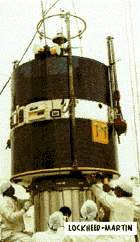SCATHA
Spacecraft Charging at High Altitude
 SCATHA's primary mission was to obtain information about the processes and effects of spacecraft charging, a phenomenon known to have contributed to several on-orbit satellite failures. The mission's specific objectives were to (1) obtain environmental and engineering data to allow the creation of design criteria, materials, techniques, tests and analytical methods to control charging of spacecraft surfaces and (2) collect scientific data about plasma wave interactions, substorms, and the energetic ring. (Spacecraft shown in stowed configuration, with experiment booms stowed). The spacecraft was also known as P78-2.
SCATHA's primary mission was to obtain information about the processes and effects of spacecraft charging, a phenomenon known to have contributed to several on-orbit satellite failures. The mission's specific objectives were to (1) obtain environmental and engineering data to allow the creation of design criteria, materials, techniques, tests and analytical methods to control charging of spacecraft surfaces and (2) collect scientific data about plasma wave interactions, substorms, and the energetic ring. (Spacecraft shown in stowed configuration, with experiment booms stowed). The spacecraft was also known as P78-2.
Spacecraft
Spin stabilized (~1 rpm) with 5 deg pointing accuracy. Hydrazine propulsion system
with 8 thrusters and 2 tanks. Body mounted solar cells generated 290 watts. Three 8Ahr NiCd batteries. Downlink at 8.2 kbps at S-Band from redundant 10 W transmitters. Aluminum, titanium, magnesium, glass fiber structure. Seven deployed experiment booms. 2 tape recorders with ~350 Mb storage each.
Payload
SC1 - Engineering Experiments plus VLF and HF Receviers - measured surface potentials of various spacecraft materials, measured RF waves between 0-300 kHz, 2-30 Mhz.
SC2 Spacecraft Sheath Fields Plus Energetic Ions - measured low energy electrons and ions, energetic protons, and electrons.
SC3 High Energy Particle Spectrometer - measured high energy electrons and protons.
SC4 Satellite Electron and Positive Ion Beam System - used ion and electron beam guns to control spacecraft surface potential.
SC5 Rapid Scan Particle Dertector - measured electrons and ions.
SC6 Thermal Plasma Analyzer (failed soon after initial turn on) - designed to measure thermal electrons and ions.
SC7 Light Ion Mass Spectrometer (failed soon after initial turn on) - designed to
measure light ion density, temperature and composition.
SC8 Energetic Ion Compositions Experiment - measured low energy electrons and the ion composition of energetic plasma.
SC9 UCSD Charged Particle Experiment - measured electrons and ions.
SC10 Electric Field Detector - measured DC and ELF electric fields and satellite potential.
SC11 Magnetic Field Monitor - measured DC and ELF magnetic fields.
ML12 Spacecraft Contamination Plus Thermal Control Materials Monitoring
-measured contamination rates and property changes of several thermal control material samples.
TPM Transient Pulse Monitor - supported the other experiments by providing supporting data about the electromagnetic pulse environment.
The twelve experiments had a total mass of 87 kg and consumed 110 W.
| Country of Origin | United States |
| Customer/User | USAF |
| Manufacturer(s) | Martin Marietta |
| Size | Cylinder: 1.8 m high, 1.8 m diameter |
| Orbit | 28000 km x 42000 km, 8.3 deg inclination |
| Design Life | 1 year |
| Related Sites | SCATHA Home Page |
Launch Facts
| Name | Int'l Desig. | Date | Site | Vehicle | Orbit | Mass(kg) |
| Notes | ||||||
| Scatha | 1979-007A | 1/30/79 | ESMC | Delta 2914 | HEO | 360 |
| Spacecraft charging experiments | ||||||
Information in The Mission and Spacecraft Library is provided without warranty or guarantee. USE AT YOUR OWN RISK.